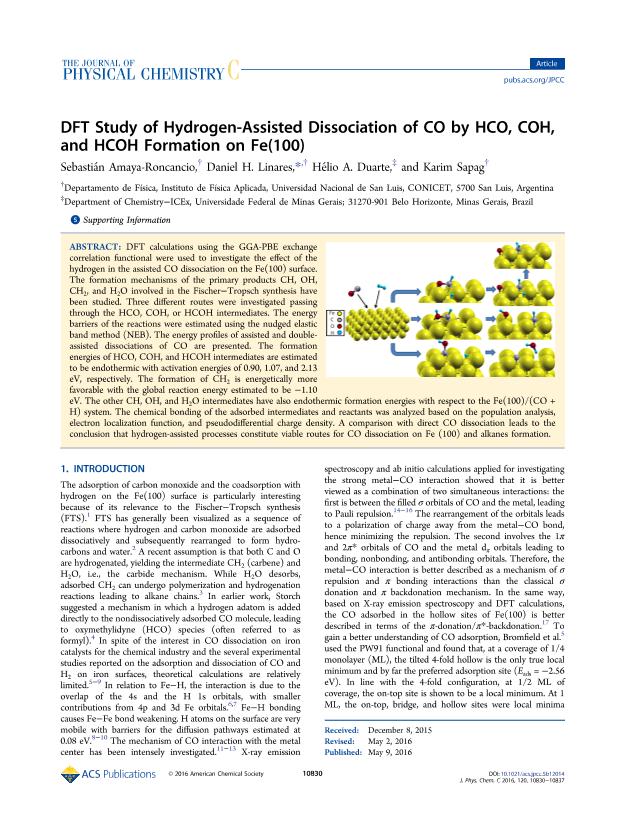Mostrar el registro sencillo del ítem
dc.contributor.author
Amaya Roncancio, Sebastian

dc.contributor.author
Linares, Daniel Humberto

dc.contributor.author
Duarte, Hélio A.
dc.contributor.author
Sapag, Manuel Karim

dc.date.available
2018-09-21T17:27:51Z
dc.date.issued
2016-05
dc.identifier.citation
Amaya Roncancio, Sebastian; Linares, Daniel Humberto; Duarte, Hélio A.; Sapag, Manuel Karim; DFT Study of Hydrogen-Assisted Dissociation of CO by HCO, COH, and HCOH Formation on Fe(100); American Chemical Society; Journal of Physical Chemistry C; 120; 20; 5-2016; 10830-10837
dc.identifier.issn
1932-7447
dc.identifier.uri
http://hdl.handle.net/11336/60574
dc.description.abstract
DFT calculations using the GGA-PBE exchange correlation functional were used to investigate the effect of the hydrogen in the assisted CO dissociation on the Fe(100) surface. The formation mechanisms of the primary products CH, OH, CH2, and H2O involved in the Fischer-Tropsch synthesis have been studied. Three different routes were investigated passing through the HCO, COH, or HCOH intermediates. The energy barriers of the reactions were estimated using the nudged elastic band method (NEB). The energy profiles of assisted and double-assisted dissociations of CO are presented. The formation energies of HCO, COH, and HCOH intermediates are estimated to be endothermic with activation energies of 0.90, 1.07, and 2.13 eV, respectively. The formation of CH2 is energetically more favorable with the global reaction energy estimated to be -1.10 eV. The other CH, OH, and H2O intermediates have also endothermic formation energies with respect to the Fe(100)/(CO + H) system. The chemical bonding of the adsorbed intermediates and reactants was analyzed based on the population analysis, electron localization function, and pseudodifferential charge density. A comparison with direct CO dissociation leads to the conclusion that hydrogen-assisted processes constitute viable routes for CO dissociation on Fe (100) and alkanes formation.
dc.format
application/pdf
dc.language.iso
eng
dc.publisher
American Chemical Society

dc.rights
info:eu-repo/semantics/openAccess
dc.rights.uri
https://creativecommons.org/licenses/by-nc-nd/2.5/ar/
dc.subject
Adsorption
dc.subject
Assisted Dissociation
dc.subject
Carbon Monoxide
dc.subject
Density Function Calculation
dc.subject
Iron
dc.subject.classification
Física Atómica, Molecular y Química

dc.subject.classification
Ciencias Físicas

dc.subject.classification
CIENCIAS NATURALES Y EXACTAS

dc.title
DFT Study of Hydrogen-Assisted Dissociation of CO by HCO, COH, and HCOH Formation on Fe(100)
dc.type
info:eu-repo/semantics/article
dc.type
info:ar-repo/semantics/artículo
dc.type
info:eu-repo/semantics/publishedVersion
dc.date.updated
2018-09-20T13:15:02Z
dc.journal.volume
120
dc.journal.number
20
dc.journal.pagination
10830-10837
dc.journal.pais
Estados Unidos

dc.journal.ciudad
Washington
dc.description.fil
Fil: Amaya Roncancio, Sebastian. Universidad Nacional de San Luis. Facultad de Ciencias Físico Matemáticas y Naturales. Departamento de Física; Argentina. Consejo Nacional de Investigaciones Científicas y Técnicas; Argentina
dc.description.fil
Fil: Linares, Daniel Humberto. Universidad Nacional de San Luis. Facultad de Ciencias Físico Matemáticas y Naturales. Departamento de Física; Argentina. Consejo Nacional de Investigaciones Científicas y Técnicas; Argentina
dc.description.fil
Fil: Duarte, Hélio A.. Universidade Federal de Minas Gerais; Brasil
dc.description.fil
Fil: Sapag, Manuel Karim. Universidad Nacional de San Luis. Facultad de Ciencias Físico Matemáticas y Naturales. Departamento de Física; Argentina. Consejo Nacional de Investigaciones Científicas y Técnicas; Argentina
dc.journal.title
Journal of Physical Chemistry C

dc.relation.alternativeid
info:eu-repo/semantics/altIdentifier/doi/http://dx.doi.org/10.1021/acs.jpcc.5b12014
dc.relation.alternativeid
info:eu-repo/semantics/altIdentifier/url/https://pubs.acs.org/doi/10.1021/acs.jpcc.5b12014
Archivos asociados
